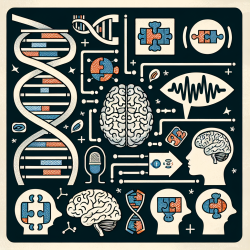Introduction
In the realm of speech-language pathology, understanding genetic disorders that impact communication and cognitive functions is crucial. One such condition is the HIDEA syndrome, characterized by hypotonia, hypoventilation, intellectual disability, dysautonomia, epilepsy, and eye abnormalities. Recent research has identified biallelic loss-of-function variants in the P4HTM gene as the cause of this syndrome. This blog post aims to provide practitioners with insights into the research findings and their implications for improving therapeutic outcomes for children affected by HIDEA syndrome.
The Research Findings
The study titled "Biallelic loss-of-function P4HTM gene variants cause hypotonia, hypoventilation, intellectual disability, dysautonomia, epilepsy, and eye abnormalities (HIDEA syndrome)" provides a comprehensive analysis of the genetic underpinnings of HIDEA syndrome. The research involved international collaboration and exome sequencing to identify patients with biallelic P4HTM variants. The study found five different pathogenic variants across new and previously identified patients, leading to the conclusion that these variants result in loss-of-function, thereby causing the syndrome.
Implications for Practitioners
Understanding the genetic basis of HIDEA syndrome is essential for speech-language pathologists as it impacts the development of targeted intervention strategies. Here are some key takeaways for practitioners:
- Early Diagnosis: Recognizing the symptoms of HIDEA syndrome early can lead to timely genetic testing and diagnosis, which is crucial for planning effective interventions.
- Collaborative Care: Given the multi-systemic nature of HIDEA syndrome, practitioners should work closely with geneticists, neurologists, and other healthcare professionals to provide comprehensive care.
- Customized Therapy Plans: Understanding the specific genetic mutations can help in tailoring therapy plans that address the unique needs of each child, focusing on improving communication skills and managing associated symptoms like hypotonia and epilepsy.
- Family Education: Educating families about the genetic aspects of HIDEA syndrome can empower them to make informed decisions about their child's care and support their involvement in therapy.
Encouraging Further Research
While the current research provides significant insights, there is a need for ongoing studies to explore the full spectrum of HIDEA syndrome and its impact on communication and cognitive functions. Practitioners are encouraged to stay informed about new developments in genetic research and consider participating in or supporting studies that aim to enhance our understanding of this condition.
Conclusion
The identification of P4HTM gene variants as the cause of HIDEA syndrome marks a significant advancement in our understanding of this complex condition. For speech-language pathologists, integrating these findings into practice can lead to improved outcomes for children affected by HIDEA syndrome. By fostering a collaborative approach and staying abreast of research developments, practitioners can play a pivotal role in enhancing the quality of life for these children.
To read the original research paper, please follow this link: Biallelic loss-of-function P4HTM gene variants cause hypotonia, hypoventilation, intellectual disability, dysautonomia, epilepsy, and eye abnormalities (HIDEA syndrome).










